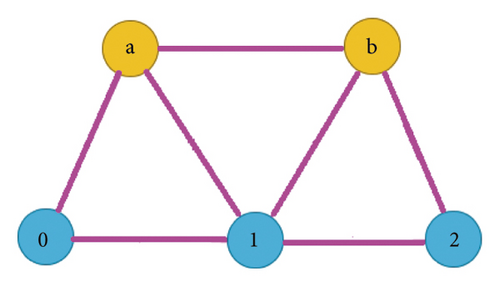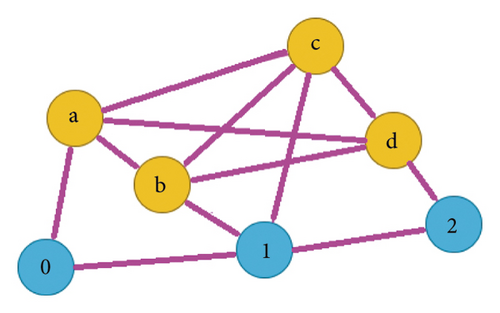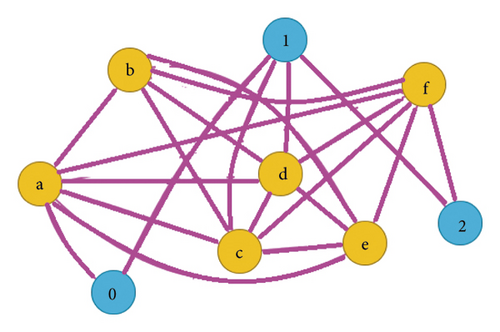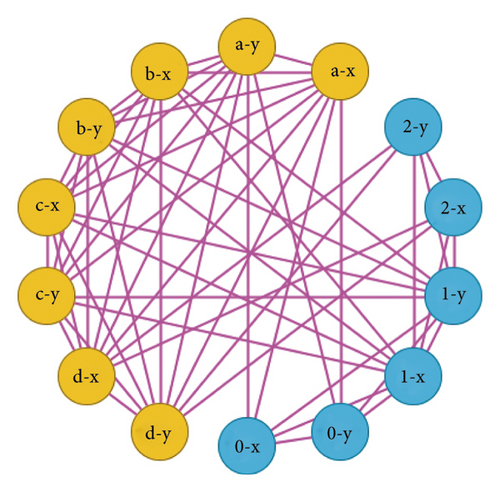[Retracted] Computing Correlation among the Graphs under Lexicographic Product via Zagreb Indices
Abstract
A topological index (TI) is a numerical descriptor of a molecule structure or graph that predicts its different physical, biological, and chemical properties in a theoretical way avoiding the difficult and costly procedures of chemical labs. In this paper, for two connected (molecular) graphs G1 and G2, we define the generalized total-sum graph consisting of various (molecular) polygonal chains by the lexicographic product of the graphs Tk(G1) and G2, where Tk(G1) is obtained by applying the generalized total operation Tk on G1 with k ≥ 1 as some integral value. Moreover, we compute the different degree-based TIs such as first Zagreb, second Zagreb, forgotten Zagreb, and hyper-Zagreb. In the end, a comparison among all the aforesaid TIs is also conducted with the help of certain statistical tools for some particular families of generalized total-sum graphs under lexicographic product.
1. Introduction
Chemical graph theory is a fascinating branch of mathematical chemistry in which the structural formulas of the different chemicals or chemical compounds are modelled as chemical structures or graphs such as the vertices correspond to the atoms and edges represent the chemical bonds between them. Topological indices (TIs) are graph-theoretic tools which are widely used in chemical graph theory to study the various structural and chemical characteristics (critical temperature, heat formation, density, extremal connectivity, unique classifications, and symmetric behaviours) of the chemical graphs. In the subject of cheminformatics, these indices also play a key role in the studies of the quantitative structure-property and quantitative structure-activity relationships which mathematically correlate the chemical properties with the physical structures of their chemical compounds. Moreover, TIs remain constant for the isomorphic structures.
In 1947, the very first TI is introduced by Wiener to check the critical temperature of paraffin [1]. Gutman and Trinajsti (1972) [2] defined the 1st and 2nd Zagreb indices that are used to compute the different structure base characteristics of the molecular graphs. These Zagreb indices are also used to measure the extent of branching of the carbon-atom skeleton of the various underlying chemical structures. After that, many degree-, distance-, and polynomial-based TIs came into existence, but the degree-based indices received more attention from the researchers (see [3–5]). For various results of the TIs on different chemical graphs, we refer to [6–8].
Li and Zheng and Bollobas and Erdos [9, 10] generalized the first and second Zagreb indices by the name of first general Zagreb index and general Randic index, respectively. In 2015, Furtula and Gutman redefined the concept of a F-index (forgotten index) with its basic properties [11]. It also measures the branching of the different atoms with predictive ability quite similar to the first Zagreb index. In the case of entropy and acentric factor, both first Zagreb and F-indices gain the correlation coefficients larger than 0.95. In addition, their linear combination yields a highly accurate mathematical model of certain physicochemical properties of alkanes. A significant improvement with the above model was obtained in the case of octanol-water partition coefficient. It is worth noting that this paper [11] has been cited more than 300 times so far. Moreover, in 2013, Shirdel et al. introduced another degree-based TI called by the hyper-Zagreb index [12]. For further study of different results on Zagreb indices, we refer to [13–15].
On the other hand, in the studies of the complex graphs, the operations on graphs (subdivision, union, intersection, switching, sum, complement, and product) play an important role to dissolve this complexity by constructing the new graphs where old graphs are distinguished by the name of the factor graphs. Yan et al. [16] defined the total operation T1 and obtained the total graph T1(G) by applying the operation T1 on graph G. They also computed the Wiener indices of this newly derived graph. Liu et al. defined the extended version of this operation called generalized total operation for any integral value of k ≥ 1 and obtained the generalized total graph Tk(G) [17]. Eliasi and Taeri [18] defined the total-sum graph (T1-sum graph) with the help of the total operation and Cartesian product of graphs. They also computed the Wiener index of this total sum graph. Moreover, Deng et al. [19], Akhter and Imran [20], Chu et al. [21], and Liu et al. [22] computed the various indices of the T1-sum graph based on the Cartesian product. The results related to Zagreb indices for T1-sum graph under strong product can be found in [7, 23]. For further study, we refer to [24, 25].
Moreover, Sarala et al. [26], De [27], Pattabiraman et al. [28, 29], and Suresh et al. [30] computed first, second, forgotten, and hyper- and reformulated Zagreb indices for the total sum (T1-sum) graph, respectively, where the T1-sum graph is obtained with the help of the total operation and lexicographic product of graphs.
In this note, we defined the concept of the generalized total-sum graphs under the operation of generalized total operation and lexicographic product of two connected graphs. Moreover, we computed the different Zagreb indices such as first, second, forgotten, and hyper for the generalized total-sum graphs in terms of different TIs of factor graphs. A computing analysis among all the aforesaid TIs is also conducted with the help of the certain statistical tools for some particular families of lexicographic product and generalized total-sum graphs. The rest of the paper is distributed in Sections 2, 3, 4, and 5 which cover the methodology, construction of graphs, main results, and regression modelling and conclusion, respectively.
2. Methodology
Let G = (V(G), E(G)) be a simple, finite, and undirected graph with a vertex set V(G) and edge set E(G)⊆V(G) × V(G), where |V(G)| and |E(G)| are called the order and size of the graph G, respectively. For a vertex or node v ∈ V(G), the number of incident edges on v or the adjacent vertices with v is called its degree, where the set of these adjacent vertices is known by the neighborhood set of v in G (denoted by NG(v)). For more basic terminologies, we refer to [31]. Now, we defined some TIs which are frequently used in the main developments of the present study.
Definition 2 (see [9].)The first general Zagreb index of a graph G is
Definition 3 (see [10].)The general Randi index (GRI) of a graph G is
For α = 2 and 3, the first Zagreb index and forgotten topological index are two special cases of the first general Zagreb index, respectively. Similarly, the first general Randi index becomes second Zagreb index for α = 1.
Definition 4 (see [12].)The hyper-Zagreb index of a graph G is
For further study of TIs, we refer [32, 33]. Now, if we assume X = G1[G2] and as dependent and independent variables, respectively, where G1[G2] is the simple lexicographic product graph of the graphs G1 and G2 and ) is the generalized total-sum graph that is a lexicographic product graph of the generalized total graphs and G2, then the simple linear regression modelling is described with H0 : Y = b0 and H1 : Y = b0 + b1X.
3. Construction of Graphs
In this section, we define different families of graphs as follows:
Definition 5 (see [16].)For a connected graph G = (V(G), E(G)), a total graph T1(G) is defined with vertex set {V(G) ∪ E(G)} and two vertices m and n in T1(G) are adjacent if either
-
m and n are in V(G) and m is adjacent to n in G or
-
m and n are in E(G) and m and n are adjacent in G or
-
m is in V(G), n is in E(G), and m and n are incident in G (for more details, see Figure 1)
Liu et al. [17] defined the generalized total graph Tk(G) with vertex set V(G) ∪ kE(G) and edge set with same conditions on the vertices as defined in Definition 5, where k ≥ 1 is some integral value. For more explanation, we refer to Figures 2 and 3.
The composition or lexicographic product of two connected graphs G1 and G2 (denoted by G1[G2]) is a graph such that the set of vertices is V(G1) × V(G2) and two vertices (x1, y1) and (x2, y2) will be adjacent in G1[G2] iff: [x1 = x2 and y1 is adjacent to y2] or [x1 is adjacent to x2 and y1 is adjacent to y2] [31]. Now, we define the generalized total sum graph under the operations of generalized total operation and lexicographic product of graphs as follows.



Definition 6. Let G1 and G2 be two connected graphs; the generalized T-sum graph is a graph having vertex set = V(Tk(G1)) × V(G2) = (V(G1) ∪ k(E(G1))) × V(G2) and edge set such as two vertices (x1, y1) and (x2, y2) of are adjacent iff [x1 = x2 in V(G1) and y1 is adjacent to y2 in E(G2)] or [x1 is adjacent to x2 in E((Tk(G1))) and y1 is adjacent to y2 in E(G2)], where k ≥ 1 is a positive integer. For more explanation, we refer to Figure 4.

4. Computational Results of Zagreb Indices
This section covers the main computational results.
Theorem 1. For two connected graphs G1 and G2 with |V(G1)|, |V(G2)| ≥ 4, and k ≥ 1, we have
Proof. Consider
Now, we take
Consequently, we obtained our required result.
Theorem 2. For two connected graphs G1 and G2 with |V(G)1|, |V(G2)| ≥ 4, and k ≥ 1, we have
Consider
Hence proved.
Theorem 3. For two connected graphs G1 and G2 with |V(G1)|, |V(G2)| ≥ 4, and k ≥ 1, we have
Proof. Consider be the degree of a node (s, t) in the molecular graph .
Now,
Theorem 4. For two connected graphs G1 and G2 with |V(G1)|, |V(G2)| ≥ 4, and k ≥ 1, we have
Proof. Let be the degree of a node (s, t) in the molecular graph .
Now, consider
5. Comparison and Conclusion
To check the correlation between the predefined lexicographic product of two simple graphs and newly defined generalized total-sum graphs via understudy Zagreb indices, we apply the linear regression model on the obtained formulas (Theorem 1–Theorem 4) of the first, second, forgotten, and hyper-Zagreb indices. For the purpose, we consider two simple path graphs Pn and Pm and construct their lexicographic product graph Pn[Pm] and generalized total-sum graph based on the lexicographic product, where m, n ≥ 1. By using Theorem 1 to Theorem 4, the first, second, forgotten, and hyper-Zagreb indices of these graphs for different values of m and n are shown in Tables 1 and 2.
| [m, n] | |V| | |E| | M1 | M2 | F(G) | H(G) |
|---|---|---|---|---|---|---|
| (3, 3) | 9 | 24 | 276 | 764 | 1704 | 3232 |
| (4, 4) | 16 | 60 | 968 | 3868 | 8280 | 16 016 |
| (5, 5) | 25 | 120 | 2460 | 12 576 | 26 460 | 51 612 |
| (6, 6) | 36 | 210 | 5196 | 32 132 | 66 948 | 131 212 |
| (7, 7) | 49 | 336 | 9716 | 70 276 | 145 488 | 286 040 |
| [m, n, k] | |V| | |E| | M1 | M2 | F(G) | H(G) |
|---|---|---|---|---|---|---|
| (3, 3, 3) | 27 | 207 | 6948 | 58989 | 122616 | 240594 |
| (4, 4, 4) | 64 | 992 | 71232 | 1293596 | 2787376 | 5374568 |
| (5, 5, 5) | 125 | 3275 | 397920 | 1.235160 8 × 107 | 2.595604 × 107 | 5.0659256 × 107 |
| (6, 6, 6) | 216 | 8604 | 1574856 | 7.357629 6 × 107 | 1.52609976 × 108 | 2.99762568 × 108 |
| (7, 7, 7) | 343 | 19355 | 496452 | 3.24253988 × 108 | 6.67171624 × 108 | 1.315679 6 × 109 |
- (i)
First Zagreb Index. For and Y = M1(Pn[Pm]), we have Y = 2260.3506 + 0.002871X with a value of correlation coefficient 0.471 1
- (ii)
Second Zagreb Index. For and Y = M2(Pn[Pm]), we have Y = 1548.9242 + 0.00002654X with a value of correlation coefficient 0.953
- (iii)
Forgotten Topological Index. For and Y = F(Pn[Pm]), we have Y = 7355.407 + 0.0002013X with a value of correlation coefficient 0.9738 (see Table 3).
- (iv)
Hyper-Zagreb Index. For and Y = HZ(Pn⌊Pm⌋), we have Y = 30154.5419 + 0.0002018X with a value of correlation coefficient 0.973 7
Now, we present these values in Table 3 more precisely.
| TI’s | Value of correlation coefficient | Relationship between X and Y |
|---|---|---|
| First Zagreb index | 0.471 1 | Very strong direct relationship |
| Second Zagreb index | 0.953 | Very strong direct relationship |
| Forgotten Zagreb index | 0.9738 | Very strong direct relationship |
| Hyper-Zagreb index | 0.973 7 | Very strong direct relationship |
In this paper, we computed different Zagreb indices for the generalized total-sum graphs. To compute the correlation values, we considered certain families of graphs that belong to lexicographic product graphs and the generalized total-sum graphs under the lexicographic product for their regression lines and values of the correlation coefficients as given in Table 3. From Table 3, we obtain the following two conclusions.
Firstly, there exists a strong correlation between the lexicographic product graphs and the generalized total-sum graphs under lexicographic product via all the understudy Zagreb indices. More clearly, we can state that by increasing the number of atoms and bonds in lexicographic product graphs to obtain the generalized total-sum graphs under the lexicographic product, the chemical properties do not change their strength. Secondly, hyper-Zagreb index shows the strong correlation among all the understudy Zagreb indices by attaining value 0.9738 as shown in Table 3.
Now, we close this section with the comment that the problem is still open to investigate the comparison among the other TIs for different operations on graphs.
Conflicts of Interest
The authors declare that there are no conflicts of interest.
Open Research
Data Availability
All the data are included within this paper. However, more details of the data are available from the corresponding author upon request.




